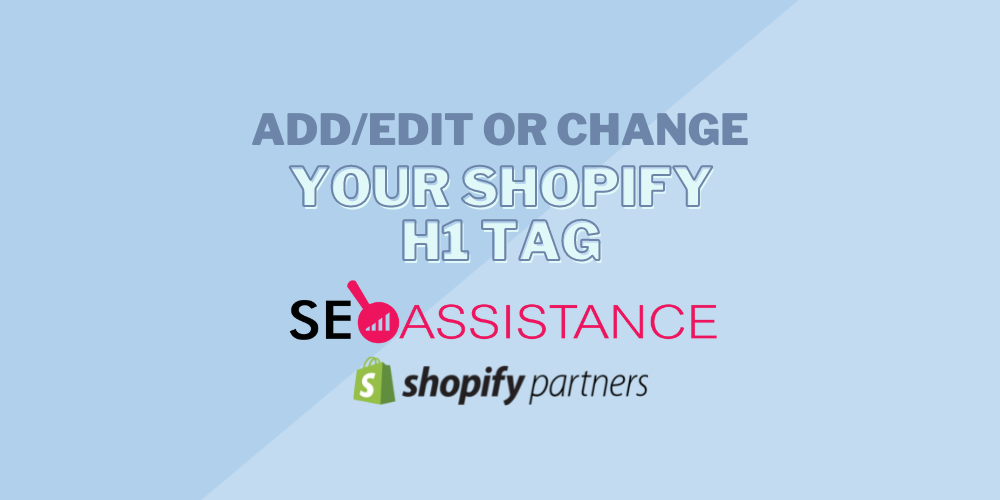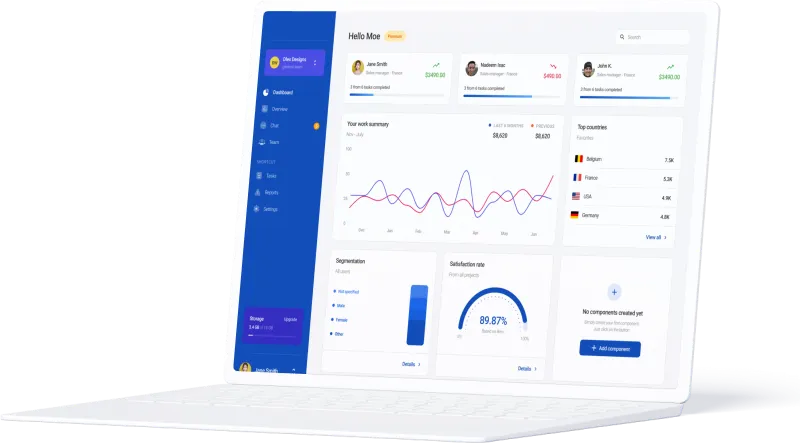How To Change/Add or Edit H1 Tag in Shopify Homepage (SOLUTION)
Learn About On Page SEO

%201.webp)

Okay, so you want to be able to either add, edit, or change your h1 tag on your Shopify homepage to help boost up your SEO efforts?
You’ve come to the right place.
Now, there’s something very important you must consider before diving right into it.
You need to figure out which specific scenario you’re in, and it’s usually one of three following scenarios:
--> Do you currently have a h1 tag but it’s showing up as empty or blank?
--> Do you have multiple h1 tags on your homepage?
--> Do you not have a h1 tag at all on your homepage?
Either way, lets cover all three different scenarios (click on the link above that matches your specific scenario and you’ll be redirected to the corresponding steps to fix it).
If you can’t figure out which scenario you’re in, feel free to send me a WhatsApp message at +61437043737 and I’ll help you out (free of charge).

SCENARIO 1 – Removing the Blank or Empty H1 Tag and Then Adding an Awesome H1 Tag on your Shopify Homepage
Before we go and add a h1 tag to your homepage, we need to identify and remove the empty h1 tag.
To do this, we’ll need to follow the following instructions (believe me, this isn’t too difficult, but if you have any trouble at all, please feel free to get in touch with me via WhatsApp (+61437043737) and I’ll help you get it done free of charge – there’s no catch, promise).
1) Find out where your empty h1 tag is located.
To do this, you can right click anywhere on the screen and click “inspect”.
After that, you can press “CTRL F” and search for “h1”.
Eventually, when you find the <h1 tag in the inspect tool and you hover over the HTML code, it’ll automatically highlight the element that the H1 tag is located in.
Keep note of this element or section.
Side Note: Most themes on Shopify usually have their blank h1 tag inside of the header section of the homepage (usually wrapped around the logo).
2) Only follow this step if the h1 tag is found inside of your header or logo.
If it’s found inside the body of your homepage or on a specific section throughout the body, then ignore this step and move onto the next point.
Firstly, go to your themes section on your Shopify dashboard and click on the arrow located next to themes, and then click on “edit code” on the drop down option.
Now, search for “logo” or “header” inside of the search bar (on the left).
Click on one of the files that come up.
The respective code for that file should show up on the right.
Press CTRL F and search for “h1”.
If you’re able to find something this way, then you just scored.
Simply remove the h1 from the beginning of the code.
Also, don’t forget to remove the closing h1 at the end of this code.
3) If the h1 tag that you found through the inspect tool is located somewhere in a section of the body, then follow the steps below.
Go to themes on your Shopify dashboard and click on “Customize”.
Locate the section where you identified your H1 tag is located in and figure out the name of that section (each section is usually named something and the Shopify theme you’re using should identify each section on your home as a specific name on this customize feature).
Once you’ve identified the section name, go back to your Shopify dashboard and click on the dropdown arrow next to the customize button, and then click on “Edit Code”.
Now use the search bar to search for the name of the section you’ve identified and click on the file that comes up.
The code of the section should now come up to the right. Use the CTRL F function to find “h1”.
Locate the opening H1 tag and remove it.
Follow that up by also removing the closing H1 tag.
4) Now that your empty h1 tag has been completely removed, it’s time to add one in.
First, locate a title in your Shopify homepage that you would like to use as your h1 tag.
Similarly to step 3 above, you’ll now need to go into your Shopify “customize” section and identify the section that this title is located in.
Once you’ve identified the section, go back into your code editor and search for that specific section with the search bar function.
Open up the file and then use the CTRL F function to identify where the title is currently located.
Usually, this would be a H2 or H3 tag, so it can save a lot of time to just search for h2 or h3 using CTRL F.
Replace the h2 or h3 with h1, and make sure to replace the closing tag at the end as well.
5) Refresh your website’s homepage and double check that you now have a h1 tag and that it has not changed the design and visual look of your title.
IMPORTANT SEO TIPS WHEN WRITING YOUR H1 TAG:
· You want your h1 tag to include the main keyword or phrase that you’re trying to rank organically for on Google.
· Your H1 tag should be the highest heading tag on the homepage (excluding any titles in the header if you have any).
SCENARIO 2 – Removing Multiple H1 Tags From Your Shopify Homepage and Making Sure You’re Only Using One.
Before we can make the perfect H1 Tag for your Shopify homepage, we need to first identify and remove the multiple H1 tags you currently have.
To do this, we’ll need to follow the following instructions (believe me, this isn’t too difficult, but if you have any trouble at all, please feel free to get in touch with me via WhatsApp (+61437043737) and I’ll help you get it done free of charge – there’s no catch, promise).
1. First, you’ll need to identify where all your h1 tags are located.
To do this, right click anywhere on the homepage and click on “Inspect”.
Use the CTRL F function to search for “h1” and find the location of all your H1 tags one by one.
Note down the current titles that the H1 tags are currently wrapped around.
2. Now go to the “Themes” section on your Shopify dashboard and click on “Customize”.
Find the names of each section that you previously identified your current H1 tags are located in.
3. Now it’s time to go back to Themes, and click on “Edit Code” by clicking on the dropdown located next to the “customize” button.
4. Use the search bar on the top left of your screen to search for the sections you’ve noted down.
5. Now click on the files that have come up (and make sure they are located in the “Sections” category) and now the code for each file should show up on the right hand side of the screen.
Again, use the CTRL F function to search for H1 and remove the opening and closing H1’s all together OR simply replace the H1’s with H2’s or whichever heading tag makes sense (make sure to understand the purpose of each heading tag and the recommended structure for heading tags before playing around too much with H2 and H3 tags).
6. Make sure to save the files after making modifications and refresh your homepage to see if your heading tags have changed in any visual way. We did this exact process on a toddlers ecommerce store and saw an almost instant improvement in organic search results.
SCENARIO 3 – Adding a H1 Tag To Your Shopify Homepage If You Don’t Have One To Begin With.
Before we go and add a h1 tag to your homepage, we need to be sure we know two things.
--> Where we’re going to add the heading 1 tag.
--> What the heading 1 tag is going to be.
To do this, we’ll need to follow the following instructions (believe me, this isn’t too difficult, but if you have any trouble at all, please feel free to get in touch with me via WhatsApp (+61437043737) and I’ll help you get it done free of charge – there’s no catch, promise).
1. First identify where you’re going to add your H1 tag on your homepage.
For optimal SEO performance, we like to add the H1 tag as close as possible to the top left side of the webpages body.
Regardless, the first step is that you need to figure out where you want to put the H1 tag.
2. For the next step, we’re going to change the H1 tag for optimal performance.
Go to the themes section on your Shopify dashboard and click on the “customize” button.
Locate the section that you want your H1 tag on and change the title to something that will perform well on Google.
Tip: Since you’re on Shopify, you’re probably an ecommerce store, and want to rank for specific keywords that will bring you product sales.
Since I don’t know your products, your industry, or your competitors, I cannot advice what your H1 tag should be for optimal performance, but if you would like to discuss it more, feel free to get in touch with me directly through WhatsApp or Email.
3. Now that we’ve actually decided on what the H1 tag should be and where it should be placed, we now need to wrap that title with a H1 tag.
To do this, locate the “Section Name” inside the Customize function on your Shopify dashboard.
4. Next, go to your “themes” section on your Shopify dashboard and click on “Edit Code” by clicking on the dropdown button located next to the “Customize” button.
5. Now, use the search bar on the top left of the screen to search for the section you previously identified.
6. Click on the section (make sure it’s a code file located inside of the section category) and the respective code should show up to the right.
7. Now, by using the CTRL F command, find the title tag by searching for “h2” or “h3” (if you’re not sure what it is, make sure to right click the title on your homepage and click on inspect. There should be a piece of code that is wrapped with a specific heading tag that reflects the title you’re inspecting. Sometimes when you click on the inspect button, it’ll automatically take you to a default code, if this is the case, please make sure to right click on the title and click on the inspect button again and you should be directed to the titles respective code).
8. Going back to the beginning of the above step, in your sections code file, replace the respective H2 or H3 tag with a H1 tag.
Also, make sure to find the closing H2 or H3 tag, and replace that with a H1 tag as well.
Don’t forget to save your work after making changes.
9. You can now refresh your homepage and doublecheck that the title hasn’t automatically changed into a different design that you do not like.
You can also now check with the right click inspect tool if your title is now wrapped with a H1 tag.
Conclusion
Having a properly written H1 tag on your Shopify homepage is essential for the success of your online store SEO performance. It helps search engines rank your page better, it improves visitor experience and navigation, and it increases the credibility of your website.
By taking the time to optimize this important element of your site, you can set yourself up for success and ensure that visitors have an easy time finding what they need when browsing through your store.
With these benefits in mind, be sure to take into account all the key points outlined above when crafting a great H1 tag for your Shopify homepage.

Want to hire us to do your SEO for you?
Simply fill out your information below. We'll audit your SEO live on video and send it to you free of charge. Simple as that.


